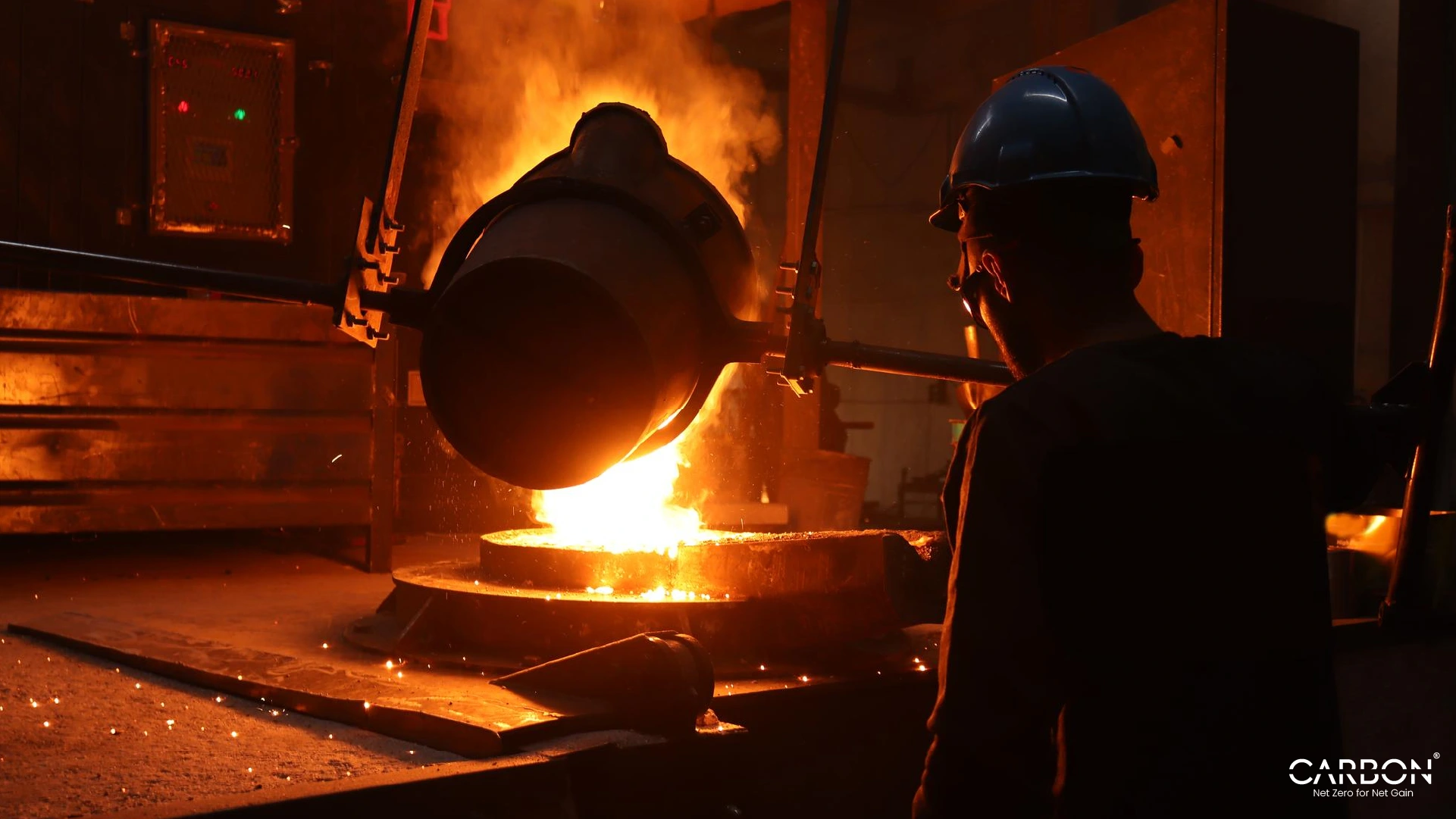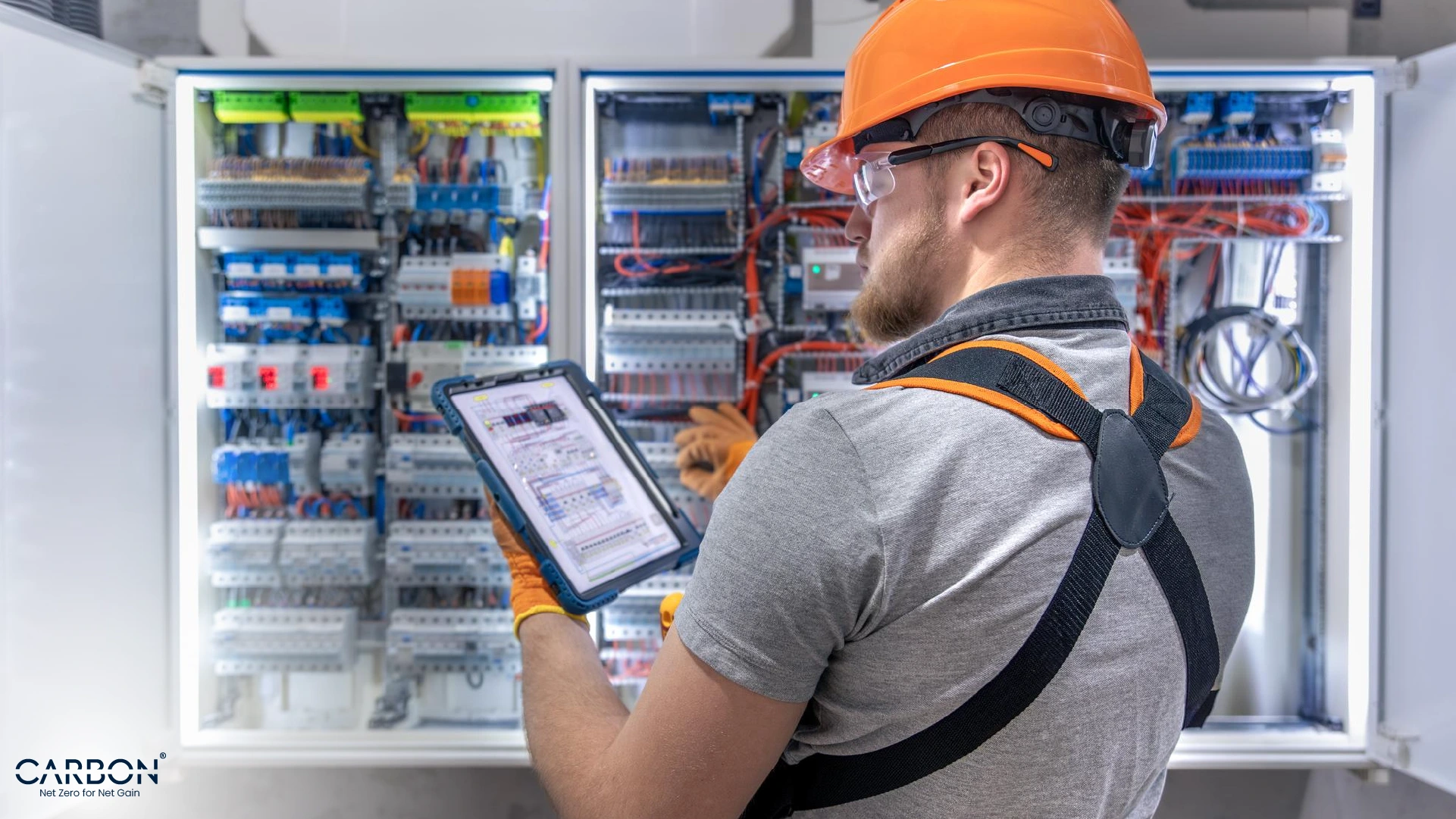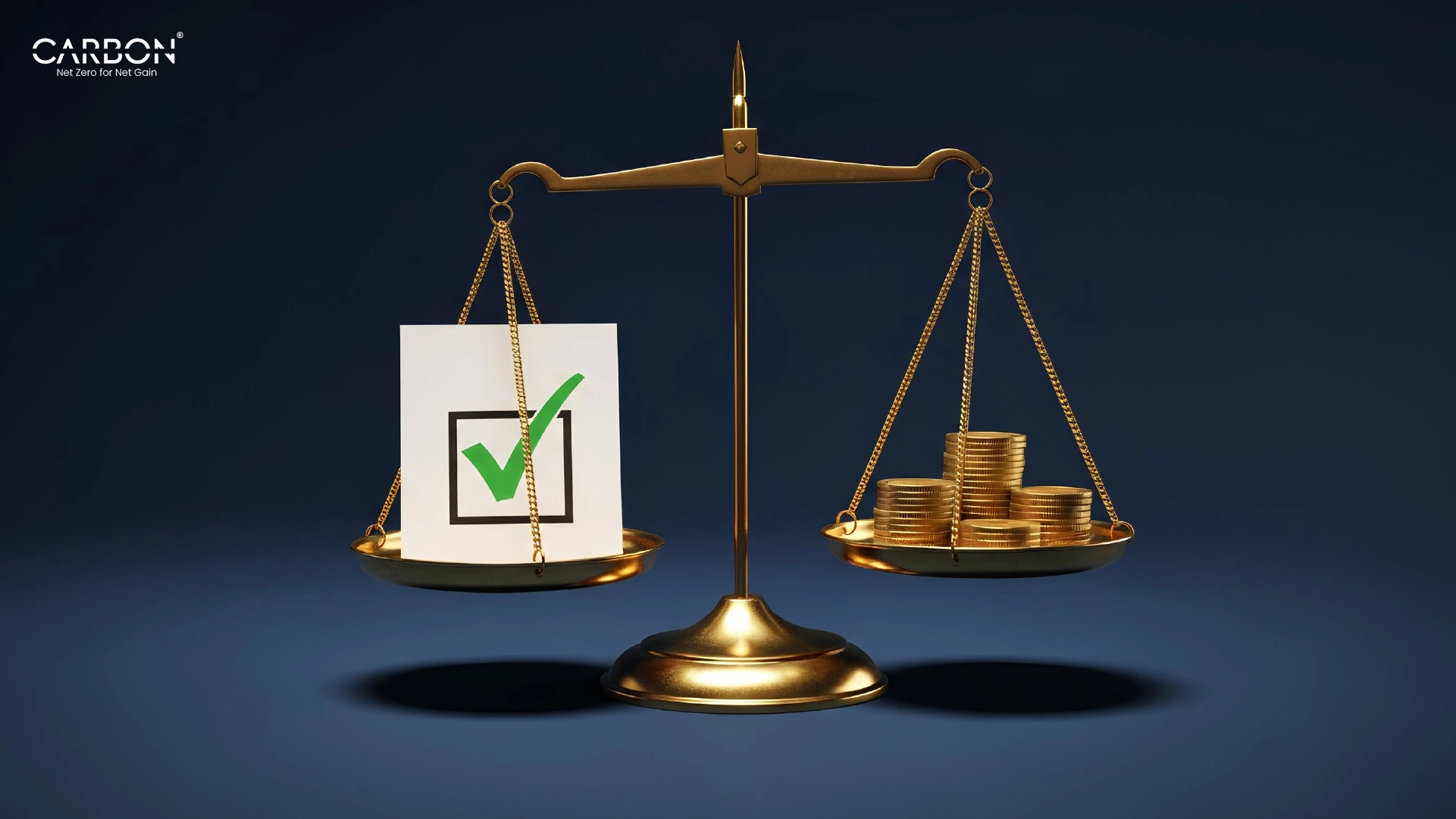Key Takeaways
- Scope 3 now carries regulatory and investor risk.
- Most emissions live in your supply chain.
- Manual data collection isn’t scalable or defensible.
- AI filters, models, and prioritizes Scope 3 actions.
- Supplier portals and hybrid modeling unlock visibility.
- A smart platform turns Scope 3 into a performance lever.
Here’s the number that changes everything: 80% to 90%.
That’s how much of your company’s carbon footprint likely lives outside your walls, in your supply chain.
Purchased goods. Logistics. Outsourced production. End-of-life waste. All of it.
That’s Scope 3. And it’s not a “nice to have” anymore.
New regulations like the EU’s CSRD are making value chain reporting mandatory.
Investors want full lifecycle transparency. Customers are asking hard questions. And if you’re still estimating emissions from a spreadsheet maze, you’re flying blind.
The era of ESG theater is over.
Scope 3 has become essential. And it’s coming with legal, financial, and reputational consequences if you get it wrong.
But here’s the good news: companies that crack the code early stay compliant and gain a real strategic edge.
In this post, we’ll break down the biggest Scope 3 pain points and show how modern platforms are using AI, data integration, and hybrid modeling to replace guesswork with clarity.
What used to be a reporting nightmare is now a chance to lead.
If you’re wondering what that shift could be worth for your business, run your numbers here.
The ROI calculator shows exactly how much you could gain by turning your value chain into a lever for sustainability and performance.
Let’s get into it.
Why is scope 3 a top priority?
Scope 3 has always been the hardest part of emissions accounting. And for years, most companies treated it like extra credit.
But that window’s closed.
Here’s what’s changed:
The regulatory mandate just landed
The EU’s Corporate Sustainability Reporting Directive (CSRD) now explicitly requires companies to report on Scope 3 emissions across their value chains.
If you operate in or sell to the EU, you’re likely on the hook.
And it’s not just the EU. Other frameworks from the SEC’s climate rule to India’s GEI-linked trading scheme are trending the same way with full-lifecycle carbon transparency.
So what used to be “aspirational” is now mandatory. This is a compliance issue with teeth.
The scope 3 black hole is real
Here’s the operational reality: Scope 3 data isn’t in your building. It’s buried across hundreds or thousands of suppliers, logistics partners, and vendors.
Every one of them uses different systems.
Different formats. Different levels of sophistication. Some don’t even track emissions at all.
Chasing that data? It’s chaos.
No wonder most companies still estimate. But estimation doesn’t hold up under audit.
And it won’t get you the insight you need to reduce emissions in any meaningful way.
The risk of inaction is growing
If your Scope 3 data is incomplete, inconsistent, or unverifiable, here’s what’s at stake:
- Failed audits
- Regulatory fines
- Lost tenders or contracts
- Investor pullout
- Reputation damage you won’t bounce back from
Even more dangerous? You can’t manage what you can’t see.
Hidden emissions hotspots in your supply chain equals hidden risks to your business.
Carbon is cost. And uncertainty kills trust.
How can technology bring clarity to scope 3?
Scope 3 isn’t impossible to manage. It’s just messy.
And mess is where good systems shine.
Here’s how leading companies are turning a data black hole into a source of strategic insight.
Step 1: Automate the funnel
Start with the foundation: data integration.
A smart platform acts like a funnel. It pulls data from your internal systems including ERP, procurement, and logistics, pairing it with inputs from your suppliers through an external portal.
Some of those suppliers will have clean, detailed data. Others won’t.
That’s fine. The key is having one place that is centralized, structured, and connected where it all lands.
You can’t analyze what you haven’t collected. This makes sure nothing falls through the cracks.
Step 2: Let AI do the heavy lifting
Once the data’s in, you hit another wall: volume.
There’s too much data for manual analysis. That’s where AI comes in. It scans thousands, even millions of data points to find the patterns. It shows you:
- Which suppliers are driving the bulk of your emissions
- Where the highest risks sit
- Where small changes could deliver big carbon savings
It’s the 80/20 rule in action powered by algorithms, not guesswork.
This is how you move from scattershot surveys to targeted supplier engagement.
It’s more efficient, more fair, and way more effective.
Step 3: Fill the gaps with smart models
Now, let’s be real. You’re never going to get perfect primary data from everyone.
But that’s not a blocker if you’re using hybrid data modeling.
A modern platform will:
- Plug in industry-average emissions factors where supplier data is missing
- Flag which numbers are modeled and which are verified
- Keep the whole thing transparent and audit-ready
The result? A full, defensible Scope 3 inventory.
Not perfect, but complete. And better every quarter.
What should a scope 3 platform actually deliver?
Let’s say you’re ready to fix the chaos. You’ve outgrown spreadsheets. You know AI is the way forward.
Now what?
Here’s what a real Scope 3 platform needs to deliver. No fluff, no gimmicks.
1. Full value chain coverage, not just the easy parts
Some tools only help you measure a slice of Scope 3 like purchased goods or freight. That’s not enough.
You need end-to-end category coverage:
- Purchased goods and services
- Capital goods
- Transportation and distribution
- Business travel
- Waste
- End-of-life treatment
- Use of sold products
Why? Because regulators aren’t grading on a curve. And real emissions reductions come from seeing the whole picture, not just what’s convenient.
2. A supplier portal that actually works
If your suppliers can’t submit data easily, they won’t submit it at all.
You need a clean, intuitive portal where suppliers can:
- Upload their emissions data
- View performance benchmarks
- Get guidance on how to improve
- Collaborate with you on reduction targets
This is about turning your supply chain into a team. And that only works if the system is built with suppliers in mind, instead of just your internal ops.
3. Scenario tools that help you make decisions
Collecting data is great. But you’re not just here to report. You’re here to act.
That’s why your platform needs analytics and modeling tools that let you ask real questions:
- What happens if I switch to a lower-carbon material?
- Which supplier changes give me the most emissions impact per dollar spent?
- How do I hit my target while keeping margins intact?
This is where compliance turns into strategy. Along with answering regulators, you can make informed decisions to make your business stronger.
From Reporting to Leadership
Scope 3 isn’t a side project anymore. It’s the main event.
For most companies, it’s the biggest part of their carbon footprint and now, it’s a regulatory obligation.
But it’s also an opportunity. If you get ahead of it, Scope 3 becomes more than a compliance headache.
It becomes a lever for innovation, resilience, and smarter decision-making.
The companies that win will be the ones who build real systems, ones that integrate data, scale supplier collaboration, and make reduction decisions actionable.
This is how you stay in control, keep your business profitable, and achieve your sustainability goals.
Ready to Move From Scope 3 Reporting to Scope 3 Leadership?
You don’t have to chase data forever. You can build a system that brings it to you in a clean, centralized, and strategic way.
Use the CarbonMinus ROI calculator to achieve real business value. Add your annual energy bill and industry, and get your result in seconds.
Want to talk specifics? Schedule a consultation and we’ll show you how this works across your supply chain.
The tools are here. The pressure isn’t slowing down. Let’s build something better.
FAQs
Why is Scope 3 such a big deal?
Because the regulators stopped treating it like a “bonus round.” The EU’s CSRD and other emerging standards now require value chain reporting. And for most companies, Scope 3 makes up the bulk of total emissions, so ignoring it isn’t an option anymore. It’s become a core compliance and business risk.
What makes Scope 3 so hard to measure?
You don’t control the data. It lives across hundreds or thousands of suppliers, transport partners, and vendors. Everyone uses different systems, formats, or none at all. Some don’t even track emissions. It’s a mess of missing, inconsistent, and incompatible data and you’re still expected to make sense of it.
What happens if our Scope 3 reporting isn’t complete?
Best case? You lose credibility with investors and customers. Worst case? You fail an audit, take a reputational hit, or face fines. But there’s also the hidden cost: if you don’t have visibility into your supply chain emissions, you can’t spot risk or reduce impact. And that’s a missed opportunity.
We already ask suppliers for data manually. Isn’t that enough?
Not anymore. Manual supplier surveys are slow, inconsistent, and don’t scale. A modern platform automates collection, flags issues, and even helps suppliers improve their own data over time. That’s the difference between checking boxes and building a real value chain strategy.
What if our suppliers can’t give us complete data?
They probably can’t. And that’s okay if your system fills the gaps intelligently. A smart platform uses hybrid modeling: actual data when available, and high-quality, auditable estimates when it’s not. This delivers transparency and helps you stay ahead of regulations.
Will this integrate with our existing ERP or procurement systems?
It should. If it doesn’t, it’s the wrong platform. You need something that pulls procurement data from your ERP and lets you match it to emissions data automatically. That’s how you avoid duplicating work and unlock real insights without reengineering your stack.
How do we know if this kind of system will pay off?
You don’t have to guess. Use this ROI calculator to see how much return you could earn for your business in terms of annual energy savings, which then translates to lower emissions and more sustainable operations. So, the upside’s real and measurable.




